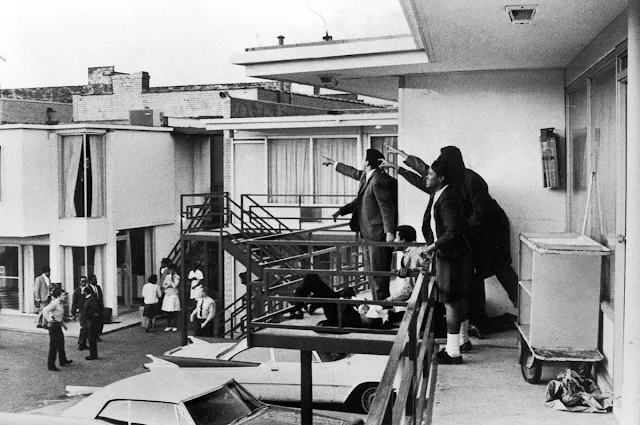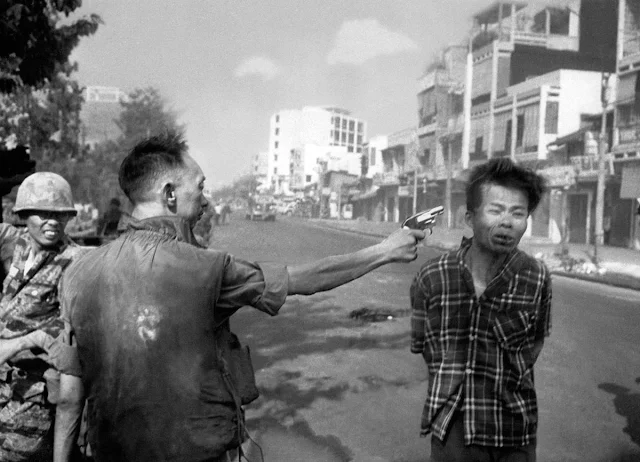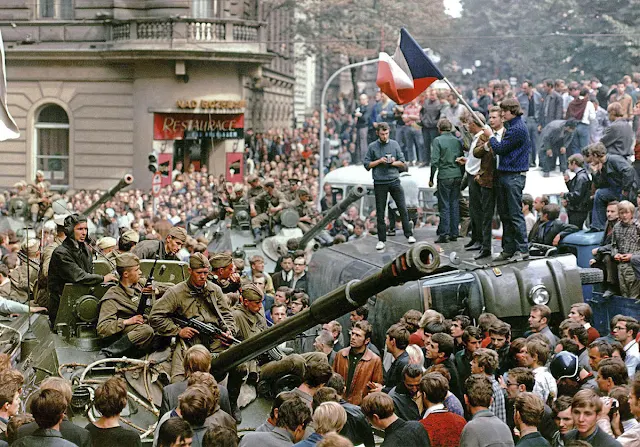(...Cont.)
ALAN TAYLOR JAN 10, 2018
https://www.theatlantic.com/photo/2018/01/50-years-ago-in-photos-a-look-back-at-1968/550208/
A half-century ago, much of the world appeared to be in a state of crisis. Protests erupted in France, Czechoslovakia. Germany, Mexico, Brazil, the United States, and many other places. Some of these protests ended peacefully; many were put down harshly. Two of the biggest catalysts for the protest were the U.S. involvement in the Vietnam War and the ongoing lack of civil rights in the U.S. and elsewhere. Two of America’s most prominent leaders, Dr Martin Luther King Jr. and Senator Robert F. Kennedy, were assassinated within months of each other. But some lessons were being learned and some progress was being made—this was also the year that NASA first sent astronauts around the moon and back, and the year President Lyndon Johnson signed the Civil Rights Act into law. It’s fitting that I post this retrospective today, since it is the day I was born—January 10, 1968. So, a 50th birthday present from me to you today: a look back at 1968.
One of the last pictures to be taken of Dr. Martin Luther King Jr., as he spoke to a mass rally in Memphis on April 3rd, saying he would not halt his plans for a massive demonstration scheduled for April 8 in spite of a federal injunction. Bettmann / Getty
Civil-rights leader Andrew Young (left) and others stand on the balcony of the Lorraine Motel pointing in the direction of an assailant after the assassination of civil-rights leader Dr. Martin Luther King Jr., who is lying at their feet, in Memphis, Tennessee, on April 4, 1968. Joseph Louw / The LIFE Images Collection / Getty
This aerial view shows clouds of smoke rising from burning buildings in northeast Washington, D.C., on April 5, 1968. The fires resulted from rioting and demonstrations after the assassination of Dr. Martin Luther King Jr. AP
![]()
Firemen battle a blaze on 125th Street in Harlem, New York, on April 4, 1968, after a furniture store and other buildings were set on fire after it was learned that civil-rights leader Dr. Martin Luther King Jr. had been assassinated. AP
President Johnson called federal troops into the nation's capital to restore peace after a day of arson, looting, and violence on April 5, 1968. Here, a trooper stands guard in the street as another (left) patrols a completely demolished building. Bettmann / Getty
Coretta Scott King, the widow of Martin Luther King Jr., walks on the arm of Dr. Ralph Abernathy, her husband's successor as head of the Southern Christian Leadership conference, leading about 10,000 people in a memorial march to the slain Dr. King. The King children, Yolanda, Martin III, and Dexter are at left with Harry Belafonte. Reverend Andrew Young marches next to Dr. Abernathy.
Bettmann / Getty
Original caption: DDrTimothy Leary holds a conference in New York City on February 21, 1968. The LSD advocate said he is tuning in with peaceniks and “Yippies” and hopes to have a million young people in Chicago during the Democratic Party’s convention in August. He said he hopes they will disrupt the convention through “Flower Guerrilla” warfare. At left is Abbie Hoffman, who said he is an organizer and at right is Jerry Rubin, peace movement worker. AP
1968 was truly a year of protest around the world. Here in Rio de Janeiro, Brazil, state police cavalry charge students attending a memorial mass for Edson Luis de Lima Souto, a student killed by police, at Candelaria Church on April 4, 1968. Edson had been part of an earlier protest over high prices in a restaurant in downtown Rio, and was shot by police who were trying to remove students from premises. Agencia JB / AP
Violent clashes between policeman and students take place during the May 1968 protests in Paris, France. [Editor's note: This photo replaces a previous image in this position that had been mislabeled by the source.] Jacques Haillot / Apis / Sygma via Getty
![]()
A massive anti-Vietnam war demonstration in London on March 18, 1968. Hundreds were arrested as they demonstrated outside the United States embassy. Corbis via Getty
ALAN TAYLOR JAN 10, 2018
https://www.theatlantic.com/photo/2018/01/50-years-ago-in-photos-a-look-back-at-1968/550208/
A half-century ago, much of the world appeared to be in a state of crisis. Protests erupted in France, Czechoslovakia. Germany, Mexico, Brazil, the United States, and many other places. Some of these protests ended peacefully; many were put down harshly. Two of the biggest catalysts for the protest were the U.S. involvement in the Vietnam War and the ongoing lack of civil rights in the U.S. and elsewhere. Two of America’s most prominent leaders, Dr Martin Luther King Jr. and Senator Robert F. Kennedy, were assassinated within months of each other. But some lessons were being learned and some progress was being made—this was also the year that NASA first sent astronauts around the moon and back, and the year President Lyndon Johnson signed the Civil Rights Act into law. It’s fitting that I post this retrospective today, since it is the day I was born—January 10, 1968. So, a 50th birthday present from me to you today: a look back at 1968.
One of the last pictures to be taken of Dr. Martin Luther King Jr., as he spoke to a mass rally in Memphis on April 3rd, saying he would not halt his plans for a massive demonstration scheduled for April 8 in spite of a federal injunction. Bettmann / Getty
Civil-rights leader Andrew Young (left) and others stand on the balcony of the Lorraine Motel pointing in the direction of an assailant after the assassination of civil-rights leader Dr. Martin Luther King Jr., who is lying at their feet, in Memphis, Tennessee, on April 4, 1968. Joseph Louw / The LIFE Images Collection / Getty
This aerial view shows clouds of smoke rising from burning buildings in northeast Washington, D.C., on April 5, 1968. The fires resulted from rioting and demonstrations after the assassination of Dr. Martin Luther King Jr. AP
Firemen battle a blaze on 125th Street in Harlem, New York, on April 4, 1968, after a furniture store and other buildings were set on fire after it was learned that civil-rights leader Dr. Martin Luther King Jr. had been assassinated. AP
President Johnson called federal troops into the nation's capital to restore peace after a day of arson, looting, and violence on April 5, 1968. Here, a trooper stands guard in the street as another (left) patrols a completely demolished building. Bettmann / Getty
Coretta Scott King, the widow of Martin Luther King Jr., walks on the arm of Dr. Ralph Abernathy, her husband's successor as head of the Southern Christian Leadership conference, leading about 10,000 people in a memorial march to the slain Dr. King. The King children, Yolanda, Martin III, and Dexter are at left with Harry Belafonte. Reverend Andrew Young marches next to Dr. Abernathy.
Bettmann / Getty
Original caption: DDrTimothy Leary holds a conference in New York City on February 21, 1968. The LSD advocate said he is tuning in with peaceniks and “Yippies” and hopes to have a million young people in Chicago during the Democratic Party’s convention in August. He said he hopes they will disrupt the convention through “Flower Guerrilla” warfare. At left is Abbie Hoffman, who said he is an organizer and at right is Jerry Rubin, peace movement worker. AP
1968 was truly a year of protest around the world. Here in Rio de Janeiro, Brazil, state police cavalry charge students attending a memorial mass for Edson Luis de Lima Souto, a student killed by police, at Candelaria Church on April 4, 1968. Edson had been part of an earlier protest over high prices in a restaurant in downtown Rio, and was shot by police who were trying to remove students from premises. Agencia JB / AP
Violent clashes between policeman and students take place during the May 1968 protests in Paris, France. [Editor's note: This photo replaces a previous image in this position that had been mislabeled by the source.] Jacques Haillot / Apis / Sygma via Getty
A massive anti-Vietnam war demonstration in London on March 18, 1968. Hundreds were arrested as they demonstrated outside the United States embassy. Corbis via Getty




























